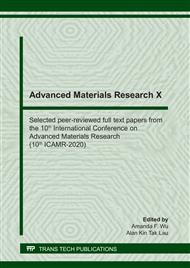p.56
p.63
p.68
p.73
p.81
p.87
p.92
p.97
p.102
Gold Nanorod-Optical Fiber for Sensing Biomolecular Interaction
Abstract:
The optical fiber deposits with gold nanorods was successfully accomplished as a biosensor device which sensing to the refractive index change on the surrounding surface. The principle is based on the localized surface plasmon resonance (LSPR) occurs on the metal surface of gold nanorods (AuNRs). The gold nanorods were coated on the glass core fiber surface through the covalent bond. The uncladded area fiber optic was incubated in 5% of (3-Mercaptopropyl) trimethoxysilane (MPTMS) in ethanol for overnight to alter the thiol group on the surface. The gold nanorods with aspect ratio ⁓2.035 was deposited on thiol surface by incubation the optical fiber in gold nanorod solution for 6 hr. The sensor provides the sensitivity of 4.94×104 a.u./RIU. Moreover, antibody for blood grouping was immobilized on the AuNRs-optical fiber to detect the red blood cells. The AuNRs-optical fiber can detect A antigen on the immobilized anti-A surface with Δ%T of 0.98 and can detect B-antigen on the immobilized anti-B surface with Δ%T of 1.78. This work possesses possibility of a simple AuNRs-optical fiber to detect the biomolecular interaction.
Info:
Periodical:
Pages:
81-86
Citation:
Online since:
July 2020
Keywords:
Price:
Сopyright:
© 2020 Trans Tech Publications Ltd. All Rights Reserved
Share:
Citation:


